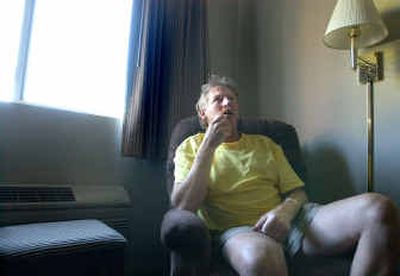Robotic heart surgery no big deal in Spokane

When Don Kaizen’s doctor told him he needed to repair a valve in his heart, the Seattle resident went to the Internet to find the best place for the surgery. The active 52-year-old didn’t like the idea of a six-to-eight-week recovery period, so he chose a procedure that uses a doctor-controlled robot to make tiny incisions in his chest, drastically reducing his down time.
Kaizen dropped a few jaws when he told friends where he was headed for such high-tech care.
” ‘You’re going to Spokane?’ ” they asked him bewildered. “Spokane doesn’t always get a lot of zazz,” Kaizen explained.
Kaizen checked into Sacred Heart Medical Center on May 25 for the procedure. By Friday afternoon, he was discharged and relaxing with his wife and their two cats at a local hotel.
Drs. Branden Reynolds and Leland Siwek performed the operation using a large console that magnifies their work 10 times on a video screen. As Siwek sat at hand controls 10 feet away, Branden stood next to the patient, inserting the robot’s surgical tools.
Siwek’s hand movements at the console followed a normal range of motion, but the machine reduced them to a miniature scale inside Kaizen’s chest. They repaired the mitral valve, using Kaizen’s own tissue and a cloth ring.
Because the doctors avoided cracking open his breastbone, Kaizen is left with five nicks near his right armpit for scars instead of a 12-inch zipper down the center of his chest.
“Because there’s no opening of the breastbone, patients can get back to normal activities much quicker,” Siwek said, adding that most could drive, go to work, and even hike or ski in two or three weeks. “With conventional surgery, it’s often two to three months before patients can resume those activities.”
Kaizen was thrilled to avoid the pain of a broken breastbone, but put it in his own terms: “You don’t work on the front of your car by going through the dashboard.”
Siwek said Kaizen is the first patient to come to Spokane from Seattle for the procedure. Although surgeons there use robotic equipment to operate on prostates, the technology isn’t used for cardiac procedures in Seattle yet.
“Seattle is a great place and has a lot of stuff available and very good heart surgery,” Siwek said. But, “Spokane has, for many years, been ahead of the curve in a lot of things and particularly in cardiac care.”
For instance, Spokane led the nation in the 1970s when it began performing emergency surgery to treat heart attacks. The procedure eventually became the standard of care.
In the 1980s, Spokane doctors were the first in the Northwest to perform a complicated open-heart repair on newborn babies. And Spokane’s Dr. Timothy Icenogle was the first in the Northwest to perform heart-and-lung transplants.
“Spokane has not been very active about promoting itself, but there’s no reason people in the Northwest shouldn’t know there’s something they can get here and not anywhere else,” Siwek said.
There actually are eight to 10 places in the country that use the robot to perform mitral valve repair, Siwek said. Only two other places besides Spokane, Atlanta and Cincinnati, do the entire procedure endoscopically.
Siwek and Reynolds perform other heart surgeries besides mitral valve repair and replacement with the robot.
Kaizen said his doctor in Seattle tried to discourage him from coming to Spokane for the operation. The doctor called the robotic procedure “experimental,” even though Siwek and Reynolds have been performing it here successfully for three years.
If Kaizen’s enthusiasm for his care here travels with him back to Seattle, more cardiac patients could be trekking over the mountains for the procedure. Looking at the view outside his window at Sacred Heart, Kaizen started composing the wording for an imaginary brochure:
“Come in for three days, have your mitral valve replaced and go skiing for three days,” he said.
More seriously, he added, “I think you’re going to find that people aren’t going to want to be busted open. It’s not exactly like the dishwasher, but a lot of people are going to want to do this.”